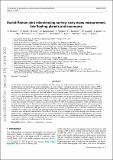Files in this item
Euclid-Roman joint microlensing survey: early mass measurement, free floating planets and exomoons
Item metadata
| dc.contributor.author | Bachelet, Etienne | |
| dc.contributor.author | Specht, David | |
| dc.contributor.author | Penny, Matthew | |
| dc.contributor.author | Hundertmark, Markus | |
| dc.contributor.author | Awiphan, Supachai | |
| dc.contributor.author | Beaulieu, Jean-Philippe | |
| dc.contributor.author | Dominik, Martin | |
| dc.contributor.author | Kerins, Eamonn | |
| dc.contributor.author | Maoz, Dan | |
| dc.contributor.author | Meade, Evan | |
| dc.contributor.author | Nucita, Achille | |
| dc.contributor.author | Poleski, Radek | |
| dc.contributor.author | Ranc, Clement | |
| dc.contributor.author | Rhodes, Jason | |
| dc.contributor.author | Robin, Annie | |
| dc.date.accessioned | 2022-05-13T16:30:16Z | |
| dc.date.available | 2022-05-13T16:30:16Z | |
| dc.date.issued | 2022-02-21 | |
| dc.identifier | 279564692 | |
| dc.identifier | ea2944f3-28d7-4f19-8e7c-2e6a0248fd75 | |
| dc.identifier | 000842657300006 | |
| dc.identifier | 85141336750 | |
| dc.identifier.citation | Bachelet , E , Specht , D , Penny , M , Hundertmark , M , Awiphan , S , Beaulieu , J-P , Dominik , M , Kerins , E , Maoz , D , Meade , E , Nucita , A , Poleski , R , Ranc , C , Rhodes , J & Robin , A 2022 , ' Euclid-Roman joint microlensing survey: early mass measurement, free floating planets and exomoons ' , Astronomy & Astrophysics . https://doi.org/10.1051/0004-6361/202140351 | en |
| dc.identifier.issn | 0004-6361 | |
| dc.identifier.other | BibCode: 2022arXiv220209475B | |
| dc.identifier.uri | https://hdl.handle.net/10023/25373 | |
| dc.description | Funding: EB gratefully acknowledge support from NASA grant 80NSSC19K0291. The work of DS is funded by a UK Science and Technology Facilities Council (STFC) PhD studentship. EK also acknowledges support from the STFC. EB, JPB and CR’s work was carried out within the framework of the ANR project COLD-WORLDS supported by the French National Agency for Research with the reference ANR-18-CE31-0002. JPB was supported by the University of Tasmania through the UTAS Foundation, ARC grant DP200101909 and the endowed Warren Chair in Astronomy. JR was supported by NASA ROSES grant 12-EUCLID12-0004, the Nancy Grace Roman Telescope, and JPL, which is run by Caltech under a contract for NASA. RP was supported by the Polish National Agency for Academic Exchange via Polish Returns 2019 grant. DM acknowledges support by the European Research Council (ERC) under the European Union’s FP7 Programme, Grant No. 833031. | en |
| dc.description.abstract | As the Kepler mission has done for hot exoplanets, the ESA Euclid and NASA Roman missions have the potential to create a breakthrough in our understanding of the demographics of cool exoplanets, including unbound, or "free-floating", planets (FFPs). In this study, we demonstrate the complementarity of the two missions and propose two joint-surveys to better constrain the mass and distance of microlensing events. We first demonstrate that an early brief Euclid survey (7 h) of the Roman microlensing fields will allow the measurement of a large fraction of events relative proper motions and lens magnitudes. Then, we study the potential of simultaneous observations by Roman and Euclid to enable the measurement of the microlensing parallax for the shortest microlensing events. Using detailed simulations of the joint detection yield we show that within one year Roman-Euclid observations will be at least an order of magnitude more sensitive than current ground-based measurements. Depending on the exact distribution of FFP, a joint Roman-Euclid campaign should detect around 130 FFP events within a year, including 110 with measured parallax that strongly constrain the FFP mass, and around 30 FFP events with direct mass and distance measurements. The ability of the joint survey to completely break the microlens mass-distance-velocity degeneracy for a significant subset of events provides a unique opportunity to verify unambiguously the FFP hypothesis or else place abundance limits for FFPs between Earth and Jupiter masses that are up to two orders of magnitude stronger than provided by ground-based surveys. Finally, we study the capabilities of the joint survey to enhance the detection and charcterization of exomoons, and found that it could lead to the detection of the first exomoon. | |
| dc.format.extent | 1790757 | |
| dc.language.iso | eng | |
| dc.relation.ispartof | Astronomy & Astrophysics | en |
| dc.subject | Astrophysics - Earth and Planetary Astrophysics | en |
| dc.subject | Astrophysics - Astrophysics of Galaxies | en |
| dc.subject | Astrophysics - Instrumentation and Methods for Astrophysics | en |
| dc.subject | QB Astronomy | en |
| dc.subject | QC Physics | en |
| dc.subject | 3rd-DAS | en |
| dc.subject.lcc | QB | en |
| dc.subject.lcc | QC | en |
| dc.title | Euclid-Roman joint microlensing survey: early mass measurement, free floating planets and exomoons | en |
| dc.type | Journal article | en |
| dc.contributor.institution | University of St Andrews. School of Physics and Astronomy | en |
| dc.contributor.institution | University of St Andrews. St Andrews Centre for Exoplanet Science | en |
| dc.identifier.doi | 10.1051/0004-6361/202140351 | |
| dc.description.status | Peer reviewed | en |
| dc.identifier.url | http://adsabs.harvard.edu/abs/2022arXiv220209475B | en |
This item appears in the following Collection(s)
Items in the St Andrews Research Repository are protected by copyright, with all rights reserved, unless otherwise indicated.

